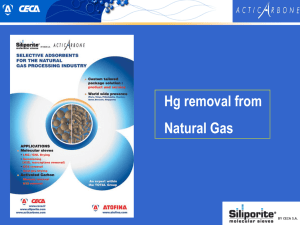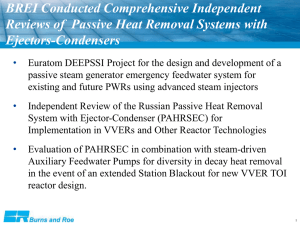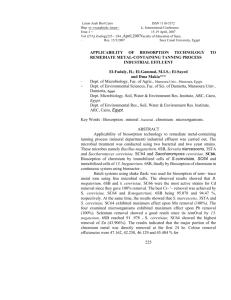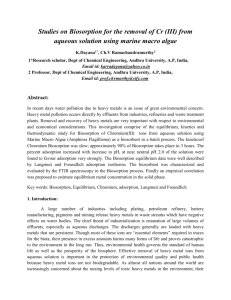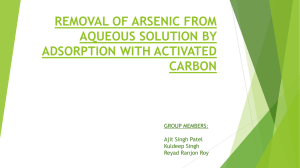The Effects and Processes for Removal of Chromium in Activated
advertisement
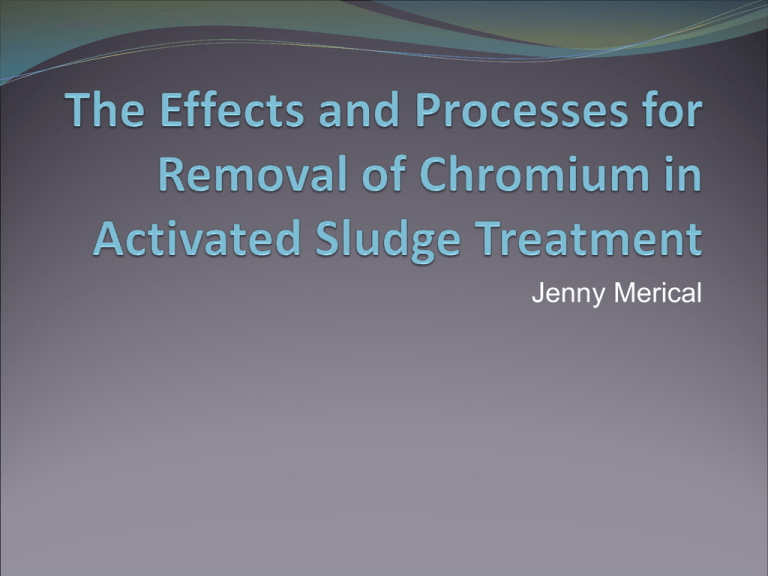
Jenny Merical Introduction Chromium Sources Biological Removal Methods Activated Sludge Absorption Capacity Biomass Growth Nitrification COD Removal Toxicity of Chromium www.euroleather.com/ Sources of Chromium Chromium Cr(VI) Cr(III) Sources Leather tanning Electroplating Wood Preservation Textile manufacturing www.seacoastventures.net www.galvanomondo.com Activated Sludge Plants in Iowa www.iamu.org Chromium Removal Methods Traditional: Chemical process Biological: Reduction of Cr(VI) to Cr(III) Adsorption Positive charged Cr(VI) attracted to negative charged microorganism cell wall Reduction of Cr(VI) to Cr(III) Most common removal mechanism Reduced then precipitated as Cr(OH)3 Metal Distribution for 1 mg/l Cr(III) Precipitated 9% Dissolved 1% Metal Distribution for 1 mg/l Cr(VI) Adsorbed 14% Adsorbed 90% Stasinakis, Thomaidis, Mamais, and Karivali et al., 2003 Precipitated 0% Dissolved 86% Activated Sludge Absorption Capacity 95% Cr(III) removal efficiency Increased removal Longer SRT Higher pH 96-99% chromium present in the form Cr(III) when anoxic selector precedes aerobic tank Stasinakis, Thomaidis, Mamais, and Karivali et al., 2003 Activated Sludge Characteristics Suspended Solids Concentration Cr(III) removal efficiency increases with a high SS concentration Cr(VI) removal did not correlate with SS concentration Sludge Age Cr(III) removal efficiency decreases as age increases Cr(VI) removal not affected by sludge age Activated Sludge Acclimation Cr(VI) and Cr(III) increase biomass lag time Cr(III) more inhibitive at concentrations less than 70 mg/L Cr(VI) more inhibitive at concentrations greater than 70 mg/L Lag time increases with increased chromium concentration Optimum growth conditions: 10 mg/L Cr(III) or Cr(VI) 11 and 17 HRT, respectively Biomass Growth 25 mg/L Cr(VI) stimulates biomass growth 15 mg/L Cr(III) stimulates biomass growth Higher concentrations limit growth Gikas and Romanos, 2006 Nitrification Nitrobacter sp. Cr(VI) interferes with nitrification Increases ammonium concentration Decreases nitrate concentration 5 mg/L decreased ammonium removal to 30% System recovery of about 12 days Cr(III) interferes at higher concentrations 25 mg/L or greater limit nitrification System recovery of about 7 days www.college.ucla.edu COD Removal Cr(VI) limits COD removal capacity No significant impact with less than 5 mg/L 5 mg/L system required 3 days to recover from loading Higher Cr(VI) concentrations More pronounced effect on COD removal Longer system recovery time Cr(VI) shock loading does not impact COD Toxicity of Chromium Microbiological effects Decrease biomass Decrease activity Decrease density Cr(VI) 100 times more toxic than Cr(III) Cr(III) less soluble Presence of sodium decreased Cr(VI) toxicity Chromium Reducing Bacteria Acinetobacter Acinetobacter Partially reduce Cr(VI) to Cr(III) Assist in chromium removal Ochrobactrum www.cns.fr Aureobacterium Hydrogenophaga Clavibacter Cellulomonas Corynebacterium www.sci.muni.cz Chromium loading on bacteria Nitrifying bacteria more sensitive than COD reducing bacteria Longer recovery time Smaller quantity/diversity of nitrifying bacteria Cr(VI) has to be toxic to several species to impact COD reducing bacteria Shock loading Lethal to Cr(VI) reducing bacteria 9.25-211 mg/L Range implies different toxicity levels Chromium Reducing Protozoa Vorticella Species: Vorticella Opercularia Stalked ciliates Free swimming ciliates Rotifers plantphys.info Free swimming ciliates dominate 5 mg/L Cr(VI) toxic to all protozoa Opercularia in high Cr(VI) concentration www2.ac-lyon.fr Activated Sludge Chromium Removal Advantages Self sufficient communities Stimulate biomass growth at optimum concentration Some microorganisms assist in chromium removal Possibly more economical Drawbacks Inhibits nitrification process (25 mg/L) Inhibits filamentous bulking Increased biomass growth lag time Limits COD removal Limits microorganism diversity Conclusion Activated sludge sufficient for chromium removal 95% removal efficiency by absorption Reduction of Cr(VI) to Cr(III) Couple with nitrification process Improve chromium removal: Lower activated sludge age Avoid high concentrations Longer SRT Higher pH Increase Suspended Solids
